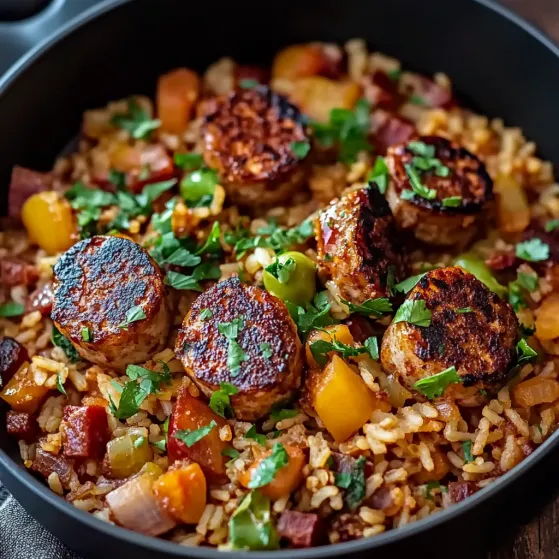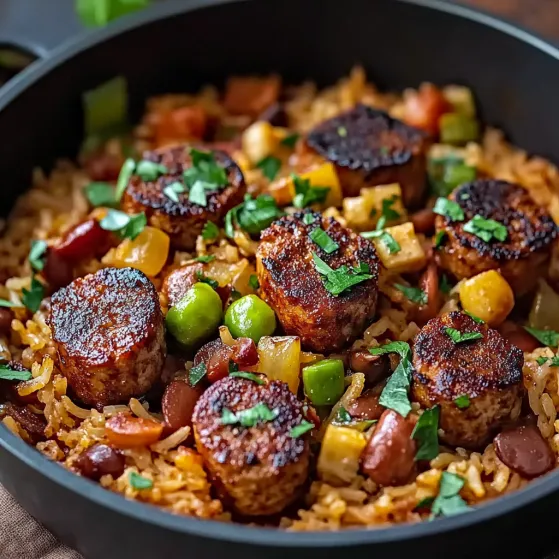 Pin it
Pin it
A hearty one-pan Cajun Sausage and Rice Skillet transforms humble ingredients into a flavor-packed meal that captures the essence of Louisiana cooking. This skillet dinner combines smoky sausage with vibrant bell peppers, aromatic onions, and perfectly cooked rice, all infused with bold Cajun seasonings. The beauty lies in its simplicity – just 30 minutes from prep to table, making it perfect for busy weeknights when you need something satisfying without spending hours in the kitchen.
I made this skillet dinner last Thursday when my sister dropped by unexpectedly. With just what I had in the fridge, I threw this together and she couldn't stop raving about it. My teenage son even asked for the leftovers in his lunch the next day – a true miracle in my household!
Key Ingredients
- Smoked Sausage (12 oz): Andouille is traditional and provides authentic Cajun flavor, but Polish kielbasa works beautifully too. Look for sausage with visible spices and a firm texture.
- Long-grain White Rice (1 cup): Provides the perfect foundation that absorbs flavors while maintaining distinct grains. Always rinse until water runs clear to remove excess starch.
- Bell Peppers (1 red, 1 green): The classic "holy trinity" component that adds sweetness, color, and nutrition. Choose firm peppers with bright, unwrinkled skin.
- Yellow or White Onion (1 medium): Forms the aromatic base. Yellow onions offer a slightly sweeter profile that balances the spice.
- Garlic (3 cloves): Fresh minced garlic is non-negotiable for authentic depth of flavor.
- Chicken Broth (1½ cups): Infuses the rice with savory richness. Low-sodium versions allow better control of salt levels.
- Cajun Seasoning (2 tbsp): The soul of this dish. Look for blends with paprika, thyme, oregano, garlic, and cayenne.
- Olive Oil (1 tbsp): Used for sautéing, adds a subtle fruity note. Any neutral cooking oil works in a pinch.
Detailed Cooking Instructions
- Step 1:
- Slice sausage into uniform ½-inch rounds to ensure even cooking. Dice bell peppers and onion into pieces roughly the same size (about ¼-inch) for consistent cooking. Mince garlic finely rather than crushing for better distribution of flavor. Rinse rice under cold running water in a fine-mesh sieve, swirling with your fingers until water runs clear – this step prevents gummy rice.
- Step 2:
- Heat olive oil in a large, heavy-bottomed skillet (cast iron works beautifully) over medium heat until it shimmers but doesn't smoke. Add sausage slices in a single layer, allowing space between pieces. Let them brown undisturbed for 2-3 minutes before flipping to develop a caramelized crust. Cook another 2-3 minutes until edges are crispy and fat has rendered. Remove to a paper towel-lined plate, leaving the flavorful drippings behind.
- Step 3:
- Add diced onions and bell peppers to the sausage drippings, stirring to coat. Sauté for about 3 minutes, stirring occasionally, until vegetables begin to soften but still retain some texture. Their moisture will help deglaze the pan, incorporating the browned bits from the sausage. Add minced garlic during the final minute, stirring constantly to prevent burning. You'll know it's ready when the kitchen fills with its aromatic fragrance.
- Step 4:
- Add rinsed, drained rice to the vegetable mixture, stirring to coat each grain with oil. Toast for 2 minutes, stirring frequently. This crucial step opens up the starch molecules, allowing them to release slowly for perfectly tender, separate grains. You'll notice the rice becoming slightly translucent at the edges and developing a subtle nutty aroma.
- Step 5:
- Pour chicken broth in slowly while stirring to prevent temperature shock. Add Cajun seasoning, distributing it evenly throughout. Bring mixture to a full boil, then immediately reduce heat to low. Cover with a tight-fitting lid – if steam escapes, place a kitchen towel between pot and lid. Simmer undisturbed for 17-20 minutes until liquid is absorbed and rice is tender but still has a slight bite. Resist the urge to peek or stir!
- Step 6:
- Gently fold the reserved sausage back into the rice mixture, being careful not to mash the rice. Replace the lid and remove from heat, allowing it to steam for 5 additional minutes. This resting period is essential for even moisture distribution and flavor melding. Give it a final gentle fluff with a fork before serving.
 Pin it
Pin it
I'm particularly partial to using true Andouille sausage in this recipe. My grandmother, who grew up outside New Orleans, insisted on it. When my children were young and sensitive to spice, I would use kielbasa instead, gradually introducing them to spicier versions as their palates developed. Now my adult daughter requests this dish whenever she visits from college.
Perfect Rice Every Time
Anyone who's attempted rice dishes knows the frustration of ending up with mushy or undercooked grains. The secret to perfect rice in this skillet meal lies in three critical steps. First, rinsing removes excess starch that causes clumping. Second, toasting the grains before adding liquid creates a protective barrier that helps maintain individual grain integrity. Finally, allowing the rice to rest off-heat after cooking lets the moisture distribute evenly. I've found that a heavy-bottomed skillet provides the most even heat distribution, preventing hot spots that can lead to inconsistent cooking. These techniques transformed my rice dishes from inconsistent to restaurant-quality results every time.
Customizing Your Cajun Experience
This skillet dish welcomes creative variations while maintaining its soulful Cajun character. For a seafood twist, add a half-pound of cleaned shrimp during the final 5 minutes of cooking. Vegetarians can substitute plant-based sausage and vegetable broth without sacrificing flavor. If you're watching carbs, cauliflower rice works beautifully – just reduce the liquid to ¾ cup and cooking time to about 8 minutes. My family enjoys a "loaded" version with a cup of black-eyed peas and a handful of chopped collard greens added along with the broth. The beauty of Cajun cooking lies in its adaptability and resourcefulness, using whatever ingredients you have on hand.
 Pin it
Pin it
The History Behind the Flavor
Cajun cuisine emerged from French Acadian immigrants who settled in Louisiana's bayou country in the 18th century. Their resourceful cooking techniques transformed local ingredients into hearty, flavorful meals that sustained hardworking families. Traditional Cajun dishes like this skillet meal begin with the "holy trinity" of bell peppers, onions, and celery (though this recipe substitutes extra peppers for the celery). The layer-by-layer building of flavors – from browning meat to sautéing vegetables to simmering everything together – is signature Cajun methodology. Understanding these cultural techniques adds appreciation for this humble yet sophisticated cuisine. When we prepare dishes like this Cajun Sausage and Rice Skillet, we're not just making dinner; we're participating in a rich culinary tradition that has evolved over centuries.
Frequently Asked Questions
- → Can I use a different type of sausage?
Yes, you can substitute with your preferred sausage. Andouille or kielbasa are recommended for their smoky flavor, but any smoked sausage works well.
- → What other vegetables can I add?
You can add vegetables like zucchini, mushrooms, or even diced tomatoes for extra flavor and texture.
- → Can I use brown rice instead of white rice?
Yes, you can, but keep in mind that brown rice has a longer cook time and may require extra broth to fully cook.
- → How spicy is this dish?
The level of spice depends on the Cajun seasoning used and whether you add hot sauce. You can adjust the spice level to your taste by adding more or less of these ingredients.
- → Can I prepare this dish ahead of time?
Yes, you can prepare it ahead. Store it in an airtight container in the fridge for up to three days. Reheat on the stovetop or in the microwave, adding a splash of broth if needed to keep it moist.
